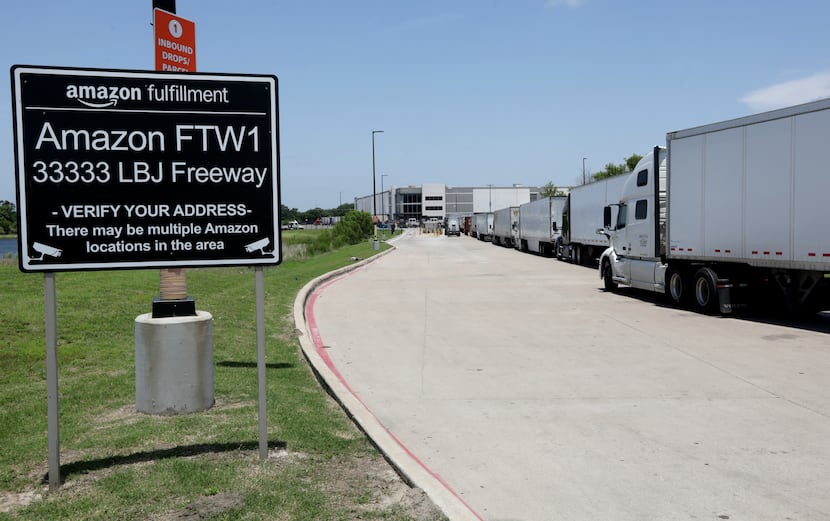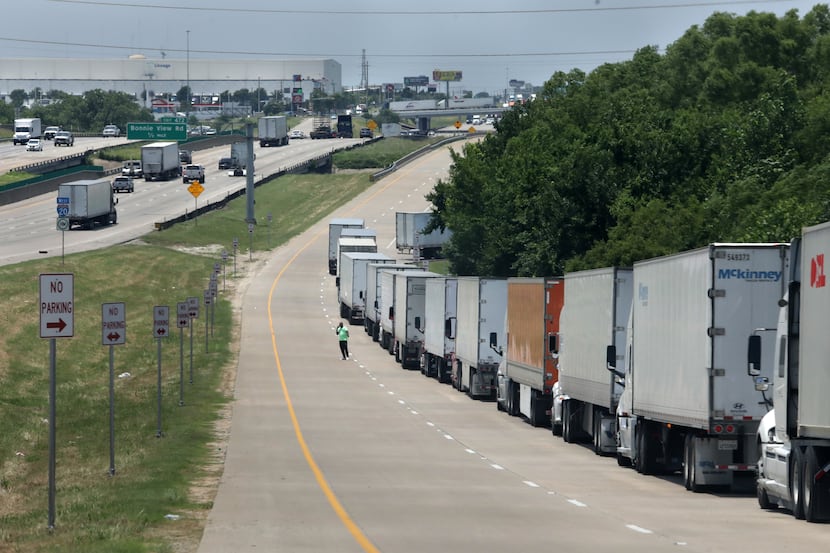Chito Peppler had been sitting in his truck for over 12 hours by the time he reached the front of the delivery line at Amazon’s fulfillment center on Interstate 20 and J.J. Lemmon Road in Dallas.
It was 3:30 a.m., and the truck driver hadn’t gotten any sleep since he’d arrived earlier that afternoon. Peppler had to stay awake so he could inch his truck upward every half hour or so. In his trailer were pallets of Pringles that were supposed to have been offloaded at 11 p.m.
“I don’t mean to complain, but there was a lot of commotion going on,” Peppler said. “I tried to doze off, but you can’t sleep because once the truck moves, you have to move.”
Peppler’s experience was frustrating, exhausting and time-consuming, but it wasn’t unique.
A line of semitrailers is always waiting to get into the fulfillment center, named FTW1 in Amazon parlance. It stretches from the warehouse entrance all the way down a frontage road off I-20.
With Amazon’s annual blockbuster Prime Day sale taking place Monday and Tuesday, the company has been stocking up its fulfillment centers for the two-day event that’s expected to generate $12 billion in sales, up from $10.4 billion last year.
But delivery lines at this fulfillment center are constant, regardless of the time of year.
The line takes up one of the two frontage road lanes. Both lanes are one-way, so other vehicles can get by. After delivering their loads, drivers then park behind the 500,000-square-foot warehouse and along nearby roads to wait to pick up their empty trailers.
Drivers say they wait for hours to drop off deliveries of merchandise that range from food to electronics to small household goods.
The drivers who get paid by the hour said it’s boring, but they don’t mind. Those paid by the trip, however, see their per-hour pay drop with every passing minute.
“I would say about $400 to $500 was wasted in lost work,” Peppler said of his 12-hour wait at the facility.
When Kevin LeDee picked up a load from a warehouse only 15 minutes away from the FTW1 fulfillment center on a Thursday evening, he thought he was in for an easy night.
He pulled up to the center, which he’d never delivered to before, at 6:30 p.m. and didn’t reach the front of the line until just before midnight. It was there that warehouse staff told him he had been waiting at the wrong place — and that he’d have to drive back to the end of the correct line.
At 11:30 a.m. the next morning, LeDee was still seven trucks away from the warehouse entrance. His eyes were bloodshot from the lack of sleep, and he still had hours to go before he could drop off his trailer, pick up another load and drive back to Houston, where he’s from.
By noon that day, 32 trucks were waiting to enter the facility. They were getting close to backing up onto the bridge that connects J.J. Lemmon and the frontage road.
“It’s like this every day. I’m always driving past here,” said David Allen of Arlington, who was waiting to drop off his trailer carrying vacuum cleaners. He arrived Thursday night at 11 p.m. for his Friday 8 a.m. drop-off time.
At 11:30 the next morning, he was only the fifth truck in line, just a couple spots ahead of LeDee. The facility has been one of his destinations the past two years, and he said he always thinks, “I hope I never have to go here again.”

The Dallas County Sheriff’s Department is as familiar with this Amazon fulfillment center as the truck drivers who frequent it.
Officers work out of a substation not far from the warehouse and drive past it regularly. Sgt. Adam Arista said the department gets recurring calls that the frontage road outside of the entrance is blocked by the trucks, making it difficult for other vehicles to pass by.
“It’s hard to always determine when these backups will occur or not,” he said. “I would say it started maybe a year and a half ago or so. It definitely picks up before the holidays.”
Eventually, Amazon hired part-time traffic control personnel to try and mitigate the risks posed with having trucks lining the side of the road.
“It does create a hazard if you have a row of large, 12-foot-in-height trucks backed up down the road,” Arista said. “They can’t see what’s coming southbound on J.J. Lemmon as they exit onto it to leave the plant.”
One Dallas County sheriff’s officer who was hired part time to work traffic control at the warehouse was struck by a passing vehicle on the bridge where J.J. Lemmon Road crosses I-20. Fortunately, the officer did not sustain serious injuries.
Another risk that worries Arista is the potential for waiting trucks to block emergency response vehicles from getting to accidents and medical events. Without adequate access to the frontage road or J.J. Lemmon Road, officers are limited in their ability to reach stretches of the interstate.
“It’ll affect our response times to major incidents at least on the westbound side of 20,” he said.
Amazon seems to be the shining example of efficiency and customer service. It’s the logistics master, shipping up to 1 million packages a day during the peak holidays from just one of its robotics-driven fulfillment centers. J.P. Morgan predicted that it could leap over Walmart to become the largest U.S. retailer in a couple of years.
So why does this one facility, which has been open since 2015, have chronic scheduling issues?
The FTW1 warehouse is one of eight such operations in Dallas-Fort Worth and one of more than 100 in the U.S. that takes in merchandise and fills customers’ orders. This facility is on the small side for Amazon. Most local Amazon fulfillment centers are about 1 million square feet, like the 855,000-square-foot fulfillment center in Arcadia Park in West Oak Cliff. The company opened another center that big last week in Forney.
Customer packages leave the fulfillment center in semitrucks and go to two other large buildings, one in Irving and one in Wilmer, where packages are sorted by ZIP code.
Local orders are packed and taken to delivery stations nestled closer to where people live. That’s where those dark blue Amazon vans with the light blue smile logo load up and head out to neighborhoods.
This year, Amazon is adding six new delivery stations to the seven it already has in North Texas. There’s one in fast-growing Frisco off PGA Parkway that opened last year and four under construction in Arlington, Mansfield and two in Fort Worth.
It all seems to hum pretty consistently.
Peppler, who writes a trucking blog under the name “18 runner,” called the fulfillment center “an atrocious operation” in a recent post after his visit to the warehouse.
“Amazon has booked way more loads than they can handle,” he wrote. “Doing so means trucks have to park out on the street, resulting in a hazard to themselves and others, or even a ticket from Dallas police. There’s an easy solution to this problem — just reduce the number of bookings.”
Amazon said the company is aware of the problems at FTW1 and is actively working to correct them by fixing the warehouse’s scheduling and increasing sorting capacity.
“This site fluctuates in inbound freight volume, which sometimes impacts wait times for trailers entering our yards,” Amazon said in an emailed response. “This is a known issue in the industry that is not unique to Amazon, and we are looking for ways to identify a solution.”


